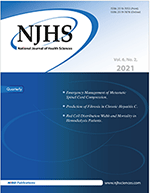Current Situation in the Struggle against Novel Coronavirus Infection (Covid-19)
Gulali Aktas
The lives of billions in the world have become to change by the end of 2019, almost two years ago, after novel coronavirus (Covid-19) infection emerged in Wuhan, China. Covid-19 caused about 33 millions of infection and 1000040 deaths worldwide within 10 months of the pandemic [1]. By December 18th of 2021, number of the infected subjects and deaths rose up to 274 million and 5364119, respectively [2].
Despite its devastating effect on human life, not even a single drug has shown significant enough efficacy against Covid-19 to change the course of the pandemic. However, some new agents and repurposed drugs were able to show efficacy to some extent. In the past 2 years, we have noticed that many Covid-19 cases have actually recovered without any treatment other than general measures. Indeed, most young and middle-aged people survive the disease mildly, yet the disease can be severe in people with advanced age and who have significant additional comorbidities. That’s why, one of the most important things to do while waiting for the pandemic to end is to take and maintain measures to prevent the spread of Covid-19 in societies. Nevertheless, as the outbreak progressed, we began to consider Covid-19-related deaths as ordinary. Unfortunately, we also loosen the tight measures to control the disease.
Received: December 19, 2021
Revised: January 07, 2022
Accepted: January 11, 2022
doi.org/10.21089/njhs.62.0044
Emergency Management of Metastatic Spinal Cord Compression
Muhammad Muaz Abbasi, Sheikh Muhammad Ebad Ali, Badar Saheto and Syed Itaat
Hussain Zaidi
Metastatic Spinal Cord Compression (MSCC) is one of the major forms of oncological emergencies. Other common emergency scenarios seen in cancer patients include Neutropenic Sepsis, Hypercalcemia and Superior Vena Cava Obstruction (SVCO). During this brief discussion of MSCC we will be going over the red flag symptoms a patient may present with common malignancies. We shall go through the points that are associated with and the multidisciplinary management of MSCC.
A patient presenting to the emergency room with symptoms including recent onset back pain [1, 2], in the extremes of age (i.e. <20 or >55), with a history of weight loss, pyrexia, night sweats, sensory loss, leg weakness, constant pain at night and at rest and/or complains of urinary retention, fecal incontinence should have MSCC considered in differential diagnosis and appropriate work up should be considered.
Received: September 16, 2021
Revised: December 09, 2021
Accepted: December 10, 2021
doi.org/10.21089/njhs.62.0046
Prediction of Fibrosis in Chronic Hepatitis C by Mean Platelet Volume and Platelet to Lymphocyte Ratio
Mehmet Ali Kosekli
Abstract: Introduction: Hepatitis C is a chronic inflammatory condition that associated with fibrosis. Novel inflammatory markers have been suggested to be related inflammatory condition. Therefore, we aimed to investigate hemogram derived indices, such as, Mean Platelet Volume (MPV) and Platelet to Lymphocyte ratio (PLR) in hepatitis C subjects and to compare those in healthy controls.
Materials and Methods: In present retrospective study, 17 HCV patients having mild fibrosis, 23 patients having advanced fibrosis and 68 control subjects were included whom visited outpatient clinics of our institution between 1.10. 2017 and 30.11.2019. Hemogram indices and laboratory characteristics were compared.
Received: September 15, 2021
Revised: October 27, 2021
Accepted: November 03, 2021
doi.org/10.21089/njhs.62.0048
Acid Base Imbalance in Dialysis: Risk Factors and Impact on Intradialysis Blood Pressure Changes. Findings from a Single Center Prospective Study in Nigeria
Peter Kehinde Uduagbamen
Abstract: Introduction: Despite improvements in hemodialysis delivery, acid base imbalance is still common in the dialysis population and it is associated with intradialysis blood pressure changes, dialysis termination, inadequacy and poor treatment outcome. We studied acid base imbalance in maintenance hemodialysis, its determinants and relationship with intradialysis blood pressure changes.
Materials & Methods: A prospective study carried out at Babcock University Teaching Hospital, Ilishan-Remo between May 2019 and April 2021 that involved 298 participants who had 1642 hemodialysis sessions.
Received: September 10, 2021
Revised: October 06, 2021
Accepted: October 07, 2021
doi.org/10.21089/njhs.62.0053
Red Cell Distribution Width and Mortality in Hemodialysis Patients: A Single Center Experience in COVID-19 Era
Mustafa Topal and Ibrahim Guney
Abstract: Introduction: Red Cell Distribution width (RDW) is found to be related with mortality in hemodialysis patients. In December 2019, a new corona virus spread was detected in China, which turned into a pandemia with significant mortality. Both RDW and chronic kidney disease were found to be related with mortality in COVID-19 patients. This study investigated if the association of RDW and mortality in hemodialysis patients still existed in the COVID-19 era.
Materials and Methods: This single center study included 117 hemodialysis patients. They were followed for 20 months (between December 2019 and July 2021) or until death. The relation of RDW with all-cause mortality and COVID-19 related deaths were studied.
Received: October 11, 2021
Revised: December 03, 2021
Accepted: December 03, 2021
doi.org/10.21089/njhs.62.0061
Intraoperative Hypotension: Immediate and Short Term Impact on Mortality. Findings from a High Dependency Cardiac and Vascular Surgical Center in Nigeria
Peter K. Uduagbamen, Michael Sanusi, Olumide B. Udom, Sule I. Ahmed, Osaze Ehioghae
and Olutomiwa A. Omokore
Abstract: Introduction: Intraoperative hypotension in cardiac surgery could be complicated by acute kidney injury (AKI), cardiac arrest and death due to poor organ perfusion. We studied intraoperative hypotension (IOH) and its immediate and short term relationship with post-operative mortality.
Materials & Methods: A retrospective study of participants, 16-86 years old who underwent cardiac and vascular surgery at Tristate Heart and Vascular Center, Ilishan-Remo, Nigeria, a high dependency cardiac and vascular surgical center between January 2015 and March 2021. Study participants were grouped into three cohorts and primary outcome was all-cause post-operative death.
Received: May 11, 2021
Revised: November 30, 2021
Accepted: December 02, 2021
doi.org/10.21089/njhs.62.0067
Role of the Gut Microbiome in the Pathophysiology and Treatment of Type 2 Diabetes Mellitus: A Mini Review
Anika Zainab, Arpit Mago, Asim Mehmood, Mohamed Riad and Sneha Rajendra Sonavane
Abstract: Introduction: Diabetes mellitus type 2 is a chronic metabolic condition characterized by insulin resistance along with inadequate circulating insulin in the blood. It has been observed that the changes in the complex habitat composed of trillions of bacteria can cause metabolic disturbances. Previous studies have explained the phenomenon of dysbiosis which leads to the development and progression of diabetes mellitus type 2. It has been reported that there are altered gut microbiota levels present in patients with type 2 diabetes mellitus.
Received: September 06, 2021
Revised: September 27, 2021
Accepted: September 29, 2021
doi.org/10.21089/njhs.62.0075
An Overview of Diabetes Mellitus in Egypt as a Major Public Health Problem
Mohamed Riad and Shorouk Elshafei
Abstract: Introduction: The prevalence of diabetes mellitus is rising rapidly in Egypt with major health and socioeconomic consequences. The shortage of endocrinologists is another important issue in Egypt that must be taken into consideration.
Objective: To review and discuss the epidemiology, risk factors, and different ways of diabetes care in Egypt. In addition, the aim is also to analyze the problem of the shortage of endocrinologists and how it can be solved.
Methods: Searching and reviewing medical literature using PubMed, Google scholar, and some other gray literature from the World Health Organization (WHO), International Diabetes Federation (IDF), and Centers for Disease Control and Prevention (CDC).
Received: September 23, 2021
Revised: November 23, 2021
Accepted: November 29, 2021
doi.org/10.21089/njhs.62.0080
An Interesting Acute Renal Failure Case which Developed in a Patient with Chronic Kidney Disease
Elif Basaran, Burcin Meryem Atak Tel, Ozge Kurtkulagi, Gizem Kahveci, Elif Boduc
Bulunmaz, Satilmis Bilgin, Tuba Taslamacioglu Duman, Muhammed Emin Demirkol and
Gulali Aktas
Abstract: Chronic Kidney Disease (CKD) is defined as a chronic and progressive deterioration in kidney functions such as, balancing fluid-solute equilibrium and metabolic-endocrine effects as a result of a decrease in glomerular filtration rate. In present case, we aimed to report an acute renal failure case in an elderly man with CKD. A sixty two year old man presented with dyspnea, leg swelling and loss of appetite for two weeks. He is diagnosed with acute exacerbation of CKD caused by infected diabetic foot ulcer. He responded well to antibiotic and diuretic treatment. Management of acute exacerbation of kidney failure in patients with CKD requires a systematic approach and elimination of underlying causes. Careful treatment usually results in restoration of kidney function to the pre-exacerbation stage.
Received: November 9, 2021
Revised: December 9, 2021
Accepted: December 9, 2021
doi.org/10.21089/njhs.62.0086
Drug-Drug Interaction between Non-Steroidal Anti-Inflammatory and Angiotensin Receptor Blocker
Mahreen Muzammil and Syed Saad Hussain
Abstract: Objective: In pharmacotherapy, factors such as mode of administration, dose, and contraindications play a significant part in determining the optimal pharmacotherapeutic strategy. A drug’s ability to influence the safety or efficacy of another drug (drug-drug interaction) is another factor to consider when choosing the best pharmacotherapy [1]. When multiple medications are prescribed at the same time, they may interact [2]. Drug-drug interactions (DDIs) can have a variety of outcomes, and adverse DDIs might result in patient death or drug withdrawal. Drug interactions can alter the pharmacokinetics and/or harmacodynamics of a drug which may leads to therapeutic failure or any adverse drug event. Co-administration of naproxen with losartan will decrease the action of losartan which is an anti-hypertensive agent leads to uncontrolled hypertension. NSAIDs inhibit prostaglandin thus antagonise effect of converting enzyme inhibitors. Losartan is angiotensin receptor blocker, whose natriuretic effects decreased by naproxen.
Received: October 25, 2021
Revised: December 31, 2021
Accepted: December 31, 2021
doi.org/10.21089/njhs.62.0088

